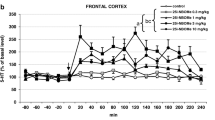Abstract
Mice were intraperitoneally dosed with trans(−)-Δ 8 tetrahydrocannabinol, various anticholinergic agents, hallucinogenics, or other behaviourally active drugs immediately prior to a habituating experience. The anticholinergic agents and trans(−)-Δ 8 tetrahydrocannabinol inhibited the subsequent influence of the habituating experience relative to the other drugs and to solvent treated subjects. The habituation modifying effects of these drugs were antagonized by tacrine, but not by d-amphetamine. The results suggest that the behavioural effects of tetrahydrocannabinols might involve an anticholinergic mechanism.
Similar content being viewed by others
References
Abood, L. G., Biel, J. H.: Anticholinergic psychotomimetic agents. Int. Rev. Neurobiol. 4, 217–273 (1962).
Ban, T. A.: Psychopharmacology. Baltimore: Williams and Wilkins 1969.
Bell, C., Gershon, S.: Experimental anticholinergic psychotomimetics: Antagonism of yohimbine and tachrine (THA). Med. exp. (Basel) 10, 15–21 (1964).
Bignami, G.: Effects of benactyzine and adiphenine on instrumental avoidance conditioning in a shuttle-box. Psychopharmacologia (Berl.) 5, 264–279 (1964).
Boren, J. J., Navarro, A. P.: The action of atropine, benactyzine, and scopolamine upon fixed-interval and fixed-ratio behavior. J. exp. Anal. Behav. 2, 107–115 (1959).
Boyd, E. S., Hutchinson, E. D., Gardner, L. C., Meritt, D. A.: Effects of tetrahydrocannabinols and other drugs on operant behavior in rats. Arch. int. Pharmacodyn. 144, 533–554 (1963).
Carlini, E. A., Masur, J.: Development of aggressive behavior in rats by chronic administration of Cannabis sativa (Marihuana). Life Sci. 8, 607–620 (1969).
Carlton, P. L.: Cholinergic mechanism in the control of behavior by the brain. Psychol. Rev. 70, 19–39 (1963).
—: Scopolamine, amphetamine, light-reinforced responding. Psychonom. Sci. 5, 347–348 (1966).
—: Brain-acetylcholine and habituation. In: P. B. Bradley and M. Fink (Eds.): Progress in brain research. Amsterdam: Elsevier 1968.
—, Didamo, P.: Augmentation of the behavioral effects of amphetamine by atropine. J. Pharmacol. exp. Ther. 134, 91–96 (1961).
Dagirmanjian, R., Boyd, E. S.: Some pharmacological effects of two tetrahydrocannabinols. J. Pharmacol. exp. Ther. 135, 25–33 (1962).
Devito, R. A., Frank, I. M.: Ditran: Searchlight on psychosis. J. Neuropsychiat. 5, 300–305 (1964).
Eger, E. I.: Atropine, scopolamine and related compounds. Anesthesiology 23, 365–383 (1962).
Farnsworth, N. R.: Hallucinogenic plants. Science 162, 1086–1092 (1968).
Glick, D. S., Jarvik, M. E.: Amphetamine, scopolamine and chlorpromazine interactions on delayed matching performance in monkeys. Psychopharmacologia (Berl.) 16, 147–155 (1969).
Grunfeld, Y., Edery, H.: Psychopharmacological activity of the active constituents of hashish and some related compounds. Psychopharmacologia (Berl.) 14, 200 to 210 (1969).
Herxheimer, A.: A comparison of some atropine-like drugs in man with particular reference to their end-organ specificity. Brit. J. Pharmacol. 13, 184–192 (1958).
Hoffer, A. D-Lysergic acid diethylamide (LSD): A review of its present status. Clin. Pharmacol. Ther. 6, 183–255 (1965).
Holtzman, D., Lovell, R. A., Jaffe, J. H., Freedman, D. X.: 1-Δ 9-tetrahydrocannabinol:Neurochemical and behavioral effects in the mouse. Science 163, 1464–1467(1969).
Innes, I. R., Nickerson, M.: Drugs inhibiting the action of acetylcholine on structures innervated by postganglionic parasympathetic nerves (antimuscarinic or atropinic drugs). In: L. S. Goodman and A. Gilman (Eds.): The pharmacological basis of therapeutics (3rd ed.). New York: Macmillan 1965.
Karczmar, A. G.: Is the central cholinergic system overexploited? Fed. Proc. 28, 147–157 (1969).
Keeler, M. H.: Marihuana induced hallucinations. Dis. nerv. Syst. 29, 314–315 (1968).
Krnjevic, K.: Central cholinergic pathways. Fed. Proc. 28, 113–120 (1969).
Lipparini, F., Scotti de Carolis A., Longo, V. G.: A neuropharmacological investigation of some trans-THC derivatives. Physiol. Behav. 4, 527–532 (1969).
Mechoulam, R.: Marihuana chemistry. Science 168, 1159–1166 (1970).
Melges, F. T., Tinklenberg, J. R., Hollister, L. E., Gillespie, H. K.: Marihuana and temporal discrimination. Science 168, 1118–1120 (1970).
Meyers, B., Roberts, K. H., Riciputi, R. H., Domino, E. F.: Some effects of muscarinic cholinergic blocking drugs on behavior and the electrocorticogram. Psychopharmacologia (Berl.) 5, 289–300 (1964).
Ostfeld, A. M., Machne, X., Unna, K. R.: The effects of atropine on the electroencephalogram and behavior in man. J. Pharmacol. exp. Ther. 128, 265–272 (1960).
Reeves, C.: Cholinergic synaptic transmission and its relationship to behavior. Psychol. Rev. 65, 321–335 (1966).
Scheckel, C. L., Boff, E., Dahlen, P., Smart, T.: Behavioral effects in monkeys of racemates of two biologically active marijuana constituents. Science 160, 1467–1569 (1968).
Shulgin, A. T.: 3-Methoxy-4,5-methylenedioxy amphetamine, a new psychotomimetic agent. Nature (Lond.) 201, 1120–1122 (1964).
Soyka, L. F., Unna, K. R.: A comparison in man of the atropinic and behavioral effects of N-allylnoratropine with atropine. Psychopharmacologia (Berl.) 6, 453–461 (1964).
Tart, C. T.: Marijuana intoxication: Common experiences. Nature (Lond.) 226, 701–704 (1970).
Warburton, D. M.: Behavioral effects of central and peripheral changes in acetylcholine systems. J. comp. physiol. Psychol. 68, 56–64 (1969).
Weil, A. T., Zinberg, N. E., Nelson, J. M.: Clinical and psychological effects of marihuana in man. Science 162, 1234–1242 (1968).
Willinsky, M. D., Webster, C. D., Herring, B. S.: Effects of Δ′tetrahydrocannabinol on Sidman discriminated avoidance behavior in rats. Paper read at Canadian Psychological Assolation Meeting, Winnipeg, May, 1970.
Wolstenholme, G. E. W., Knight, J. (Eds.): Hashish: Its chemistry and pharmacology. Boston: Little Brown 1965.
Author information
Authors and Affiliations
Additional information
The research described herein was done while the author was a Summer Research Fellow at the University of Manitoba.
The author is indebted to Dr. A.B. Morrison,Deputy Director-General, Canadian Food and Drug Directorate, Ottawa, for supplying the trans(−)-Δ 8tetrahydrocannabinol.
Rights and permissions
About this article
Cite this article
Brown, H. Some anticholinergic-like behavioural effects of trans (—)-Δ8 tetrahydrocannabinol. Psychopharmacologia 21, 294–301 (1971). https://doi.org/10.1007/BF00403868
Received:
Revised:
Issue Date:
DOI: https://doi.org/10.1007/BF00403868




